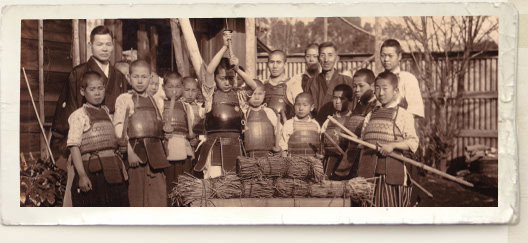
(Modern) Bogu
The bogu (防具, bógu) is a specially designed body armor, which is used by numerous japanese matrial arts, but most of all Kenjutsu, Kendo and Naginatado (naginata-jutsu). The Bogu is originated from Jikishin Kage-ryu Kenjutsu style. (v.s.: "old bogu").
The bogu kit includes as follows:
-
men (面, めん): face and shoulder protector (helmet);
-
dō (胴, どう): body protector;
-
kote (小手, こて): hand and forearm protector (gloves);
-
tare (垂れ, たれ): leg and lumbar protector;
-
sune-ate (脛当て, すねあて): shin protector (used only by practitioners of naginata and modern kenjutsu).
 The
men defends the face, neck and shoulders. The main part is the mask, which is a metal beam structure from the chin up to the head. A thick, long rectangular shaped fabric is fixed to the mask and spanned to the top of it. The ending covers entirely all of the shoulders. The last part is a throat protector and it is located at the bottom of the mask. The „men” is fixed by two pairs of woven cords, which allow you to tie the head, then knot it at the back. The back of the men is open and unprotected, because of the ventilation.
The
men defends the face, neck and shoulders. The main part is the mask, which is a metal beam structure from the chin up to the head. A thick, long rectangular shaped fabric is fixed to the mask and spanned to the top of it. The ending covers entirely all of the shoulders. The last part is a throat protector and it is located at the bottom of the mask. The „men” is fixed by two pairs of woven cords, which allow you to tie the head, then knot it at the back. The back of the men is open and unprotected, because of the ventilation.
 The
main part of the do is a midly bent stomach and chest protector. This modern shape has a specific bulge, which helps to redirect the cuts from the sensitive body parts. The traditional „do”is made of varnished bamboo, though the less expensive ones from paper fibre or formed plastic. The „do” is held by two diagonal and two additional bindings and at the bottom of your back.
The
main part of the do is a midly bent stomach and chest protector. This modern shape has a specific bulge, which helps to redirect the cuts from the sensitive body parts. The traditional „do”is made of varnished bamboo, though the less expensive ones from paper fibre or formed plastic. The „do” is held by two diagonal and two additional bindings and at the bottom of your back.
 The
pair of kotes look like two finger gloves. They apear a bit cumbrous, but actually it allows you to grip strongly with comfort and handle the shinai forcefuly. Earlier the kotes were designed with ordinary five fingers. Today it is very rare, because the overhanged fingers increased the chance of injury.
The
pair of kotes look like two finger gloves. They apear a bit cumbrous, but actually it allows you to grip strongly with comfort and handle the shinai forcefuly. Earlier the kotes were designed with ordinary five fingers. Today it is very rare, because the overhanged fingers increased the chance of injury.
 The
tare is a thick belt made of textile, which is around the hip and should be tied beneath the first wing, infront of the lumbar. Durable textile covered wings are hanging from the belt to protect the lumbar are and the legs. The wings run all along the half of the belt, which should be tied at the first half of your body. The middle wing is usually covered by a name plate (the zekken, or nafuda), which refers to the owner, the dojo and the country.
The
tare is a thick belt made of textile, which is around the hip and should be tied beneath the first wing, infront of the lumbar. Durable textile covered wings are hanging from the belt to protect the lumbar are and the legs. The wings run all along the half of the belt, which should be tied at the first half of your body. The middle wing is usually covered by a name plate (the zekken, or nafuda), which refers to the owner, the dojo and the country.
 The
sune-ate looks like a simple shin-guard (karate), but the structure
is completely different. There are six pieces of two-centimeter-wide and
20-25 cm long wooden insets, which are fixed to the outer surface of the
thick fabric. In this manner the ”sune-ate” is capable of
redirecting the cuts of the shinai or fukuro shinai. This is not only
a shin-guard, but it can also protect the knee. There are two bindings
to tie it to your leg.
The
sune-ate looks like a simple shin-guard (karate), but the structure
is completely different. There are six pieces of two-centimeter-wide and
20-25 cm long wooden insets, which are fixed to the outer surface of the
thick fabric. In this manner the ”sune-ate” is capable of
redirecting the cuts of the shinai or fukuro shinai. This is not only
a shin-guard, but it can also protect the knee. There are two bindings
to tie it to your leg.
